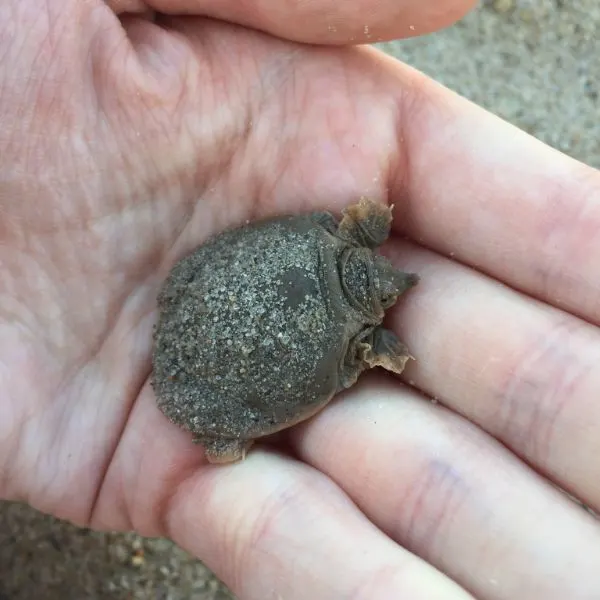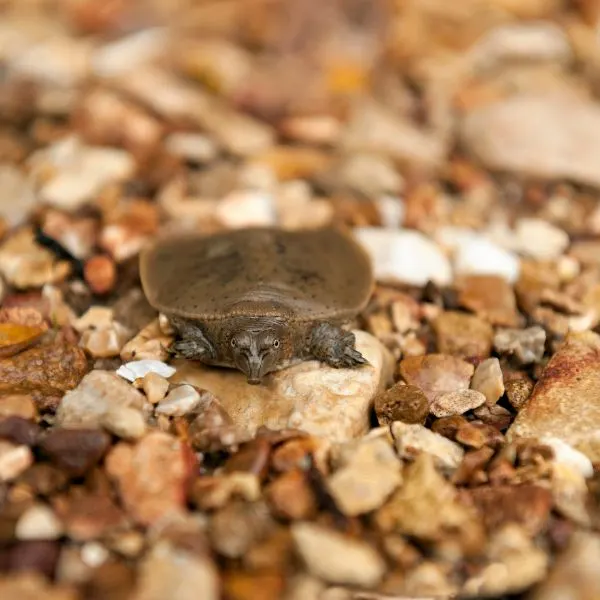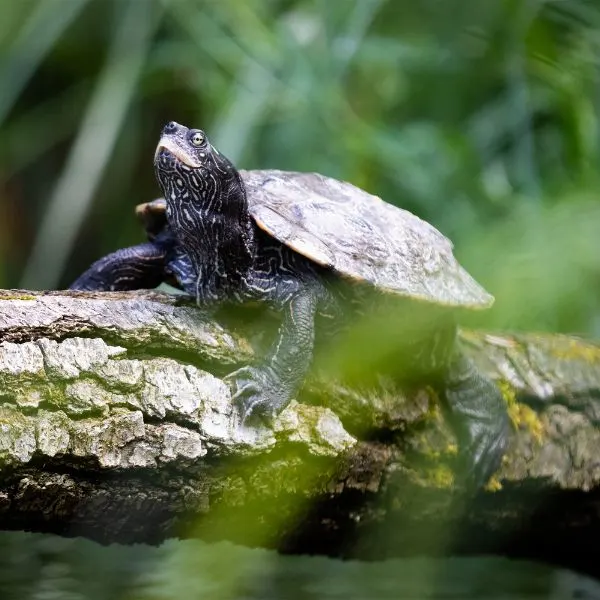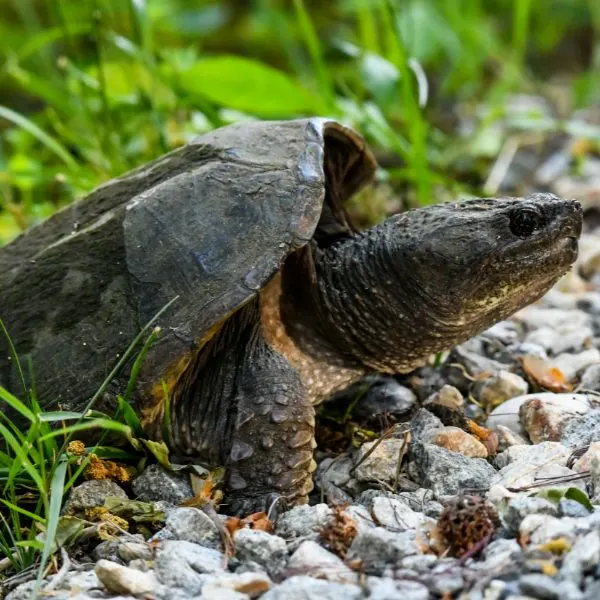There are 5 types of turtles in North Dakota, which include softshell turtles, map turtles, painted turtles, and a snapping turtle species.
The cold plains of North Dakota usually aren’t very suitable for reptiles. These cold-blooded creatures are at the mercy of outside temperatures, and most reptiles can’t survive extreme cold, but that doesn’t mean you can’t find turtles in North Dakota.
While you’re out and about in North Dakota, keep your eyes peeled and you might see these turtles in the wild.
Table of Contents
Softshell Turtles in North Dakota
1. Smooth Softshell Turtle

- Experience Level: Intermediate to Expert
- Family: Trionychidae
- Scientific Name: Apalone mutica
- Other Names: Spineless Softshell
- Adult Size: 4.5 to 14 inches
- Life Span: 25+ years
- Average Price Range: $40 to $60
- Conservation Status: Least concern
Smooth Softshell turtles are flattened turtles that have a somewhat flexible shell instead of the hard shell we are used to seeing. They are a sandy tan to dark brown in coloration and most have darker spots, circles, or blotches on their carapace (upper part of the shell).
Their plastron (bottom shell) is small and white. Their skin is usually the same color as the shell. Softshell turtles have elongated, pig-like snouts and a stripe on either side of their head.
In the water, these turtles are excellent swimmers, and they are quite swift on the land compared to other turtles. They prefer waters with fast currents such as streams and rivers and sandy bottoms.
These turtles are ambush predators that like to bury themselves in the sand and await prey items such as crayfish, amphibians, fish, insects, worms, and mollusks to get near. They will then strike out and eat the animal. They are mostly carnivorous but may consume some vegetation.
2. Spiny Softshell Turtle

- Experience Level: Intermediate to Expert
- Family: Trionychidae
- Scientific Name: Apalone spinifera
- Other Names: N/A
- Adult Size: 5 to 9 ½ inches for males, 10 to 17 inches for females
- Life Span: Between 20 and 50 years
- Average Price Range: Between $20 and $120
- Conservation Status: Threatened in some areas
Spiny Softshell turtles look quite similar to our first turtle on the list, but they have a bumpy ridge at the front of their leathery shell. They are similarly colored as well, with adults showing darker colors.
Softshell turtles love to bask in the sun. Often they are seen laying on the banks or on fallen logs when the warm sun is out.
Female Softshell turtles—it doesn’t matter if they are smooth, or spiny—are nearly twice as large as full grown males.
These turtles live in the same type of habitat as Smooth Softshell turtles. Both species are rare in North Dakota and rarely seen.
Most times these turtles run into the water when approached, but if they get cornered, they can become quite aggressive. They know their soft shell doesn’t offer much protection. Softshell turtles have a very long neck that reaches half the length of their shell and won’t hesitate to bite when they are handled.
Spiny Softshell turtles are mostly carnivorous and eat fish, amphibians, crustaceans, insects, and other aquatic invertebrates.
Map Turtles in North Dakota
3. False Map Turtle

- Experience Level: Beginner
- Family: Emydidae
- Scientific Name: Graptemys pseudogeographica
- Other Names: Sawback turtle
- Adult Size: 3.5 to 10.5 inches (9 to 26.5 cm)
- Life Span: 30 to 50 years
- Average Price Range: $6 to $40
- Conservation Status: Least concern
False Map turtles are medium sized turtles that rarely leave the water except to bask in the sun or find nesting spots. These turtles are another rare species in North Dakota. They mostly inhabit large permanent bodies of water such as lakes, reservoirs, large rivers, and oxbows.
Most species of Map turtles—this one included—are communal baskers. They will crowd outcroppings, banks, and fallen logs alongside other species of turtles. Extremely skittish, when they see anything out of the ordinary they quickly dip back into the water and hide at the bottom.
If you’re able to see these elusive turtles, you’ll notice they have green, olive, or brown carapaces with orange or yellowish swirls and stripes that look like map patterns. There is a darkened ridge in the middle of the shell that becomes less prominent as they age.
They are nicknamed the “Sawback” turtle because of the wide serrations along the marginal scutes. The skin and scales of False Map turtles are dark brown and covered in yellow or white stripes.
On their heads, False Map turtles have a pair of elongated spots behind their eyes that resemble the letter “L” or the number 7.
Painted Turtles in North Dakota
4. Eastern Painted Turtle

- Experience level: Beginner
- Family: Emydidae
- Scientific Name: Chrysemys picta
- Common Name: Painted Turtle
- Average Adult Size: 4 – 10 inches
- Life Span: 30 – 50 years
- Average Price Range: Between $30 to $150
- Conservation Status: Least Concern
Eastern Painted turtles are an aquatic species that inhabit wetlands, ponds, lakes, and other bodies of water with little current. They love to bask and will spend hours on logs or banks in the sun.
There are several subspecies of Painted turtles, all with slight physical variations. To identify the Eastern Painted turtle, look at the carapace. If you see a series of straight lines where the scutes align, you’ve found an Eastern Painted turtle.
They also have smooth, somewhat flattened shells with bright red or orange under the carapace. Their plastron is slightly smaller, pale yellow or tan, and has no other marks.
The exposed skin of Eastern Painted turtles is dark brown to black and has a lot of yellow stripes.
Painted turtles are the most abundant species in the United States. They are found from Maine to Florida, and as far west as Washington and Oregon.
Omnivores by nature, younger Painted turtles consume mostly insects, small fish, and mollusks, and adults turn to a more veggie rich diet.
Snapping Turtles in North Dakota
5. Common Snapping Turtle

- Experience level: Intermediate to Expert
- Family: Chelydrida
- Scientific Name: Chelydra Serpentina
- Other Names: Snapping Turtle, Snapper, Eastern Snapping Turtle
- Average Adult Size: 8 to 20 inches
- Life Span: 30 – 50 years
- Average Price Range: Approximately $40 to $120
- Conservation Status: Least concern
Our final turtle is the largest and most intimidating. The Common Snapping turtle can be found all across the waters of North Dakota. This turtle is known as a habitat generalist because they can make due in nearly any type of water except salty.
If you don’t know what these turtles look like, we’ll describe them. They’re big, bad, and so ugly they’re cute. What? Not good enough?
Okay. Common Snapping turtles have a solid colored carapace with three ridges running down the back. They can be olive, brown, or nearly black, and they are usually covered in mud or algae.
Though they can mostly pull themselves into their shell, when they are moving around, the shell looks very small for the long legs, neck, and serrated tail. Their spiked tail is nearly as long as their carapace.
They have a small plastron that’s usually cream colored or white. Their skin can be a dingy yellow, to dark brown. Snapping turtles have a sharp hawk-like beak, and sharp, thick nails on the front legs.
When you see one of these big turtles crawl from the water, the sight alone may make you afraid to ever enter the water again, but you have nothing to worry about. When Snappers are in the water they are very docile and will run away from people.
On land, they can become frighteningly aggressive. They will withdraw with their sharp mouths open and hiss very loudly. If this sign of aggression isn’t enough and you still try to get close or touch them, they will strike out lightning fast and bite very hard.
Common snappers don’t have enough strength in their jaws to break bones, but the sharp beak will break through skin and flesh.
Snapping turtles are omnivores, but most of them prefer to eat protein sources. They are ambush predators that sit at the bottom of the water while waiting for dinner to come to them. Here they feed on fish, crayfish, amphibians, insects, mollusks, small turtles, and if they get close enough, the occasional waterfowl.
FAQs
Can I own a turtle in North Dakota?

You can certainly own a pet turtle in North Dakota, though you’d be better off owning a small turtle that can be kept inside. The cold winters are too harsh for many species to survive outside all year long.
There are no laws surrounding the ownership, possession, or sale of turtles in North Dakota.
What is the largest turtle in North Dakota?

The largest turtle in North Dakota is the snowmobile riding turtle named Tommy the Turtle. It is a fiberglass sculpture in Bottineau, North Dakota. The giant turtle is 30 feet tall and sitting on a giant snowmobile that’s 34 feet long.
The largest living turtle found in North Dakota is the Common Snapping turtle. These turtles can’t ride snowmobiles, but they can reach lengths exceeding 19 inches, though that’s rare.
Wrapping up
We just went over the 5 turtle species found in North Carolina. If any of these turtle species strike your fancy and you want to get one as a pet, we encourage you to find a reputable breeder. Getting captive bred turtles helps cut down on pet trade poaching and helps to save wild populations.
Wild turtles don’t make good pets because they will stress so badly that they end up shortening their lives dramatically.
If you enjoyed this list, please leave us a comment below. We love hearing from readers, and you may connect with fellow herp enthusiasts.
More turtles in nearby states
